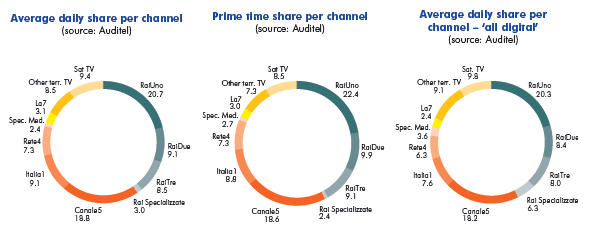home > report on operations > RAI's offering
TV product performance
2010 was characterised by further
growth of the dissemination of DTT. At
the end of the year, the all-digital
regions had become ten, accounting for
65% of the Italian population.
The most significant effects of the
expansion and diversification of the
television offering include the increase in
the television audience. 2010 was a
record year for viewing figures. Over the
whole day, 9.8 viewers were reached
(the highest value ever recorded since
the Auditel measuring system was
introduced), which the average prime
time audience was of 25.1 million
viewers (equalling the absolute record
set in 2004).
In this competitive rapidly and
dramatically evolving context,
characterized by the considerable
increase in the number of television
channels and the gradual
strengthening of the specialized digital
channels (terrestrial and satellite, free
and pay), the Rai Group confirmed its
leadership.
On an average day, Rai consolidates
its share with 41.3% (+0.7% compared
to 2009) compared to Mediaset's
37.6% (-1.9%).
This occurs within the scope of a general
increase in the shares obtained by
specialized satellite or digital terrestrial
channels: excluding the Rai and
Mediaset networks measured by Auditel,
the totality of 'satellite TV broadcasters'
rises to 9.4% (+0.2 share points on
2009), while 'Other terrestrial TV
broadcasters' reach 8.5% (+1.0%).
The positive performance of the Rai
Group is largely due to the performance
of the specialized channels ('Rai
Specializzate'), which obtain a total allday
share of 3.0% (with an increase of
+1.7 points compared to 2009),
influenced mainly by Rai 4, Rai Premium
and Rai YoYo.
This performance makes Rai Italy's
second digital broadcaster, after Sky
(3.2%) and ahead of Mediaset (2.4%),
Fox (1.8%) and all the other Italian and
international competitors such as Disney,
Switchover Media, Viacom, Discovery
Channel and Turner.
The results of Rai's specialized networks
clearly offset the physiological decline of
the three general-interest channels, with
RaiUno being confirmed as the most
watched channel of all (20.7% share; -
0.5% on 2009) and RaiTre at 8.5%
(-0.5%). The performance of RaiDue
(9.1%) has remained quite stable with
respect to 2009 (-0.1%), despite the
switch-over of important areas of the
country; In Lombardy and Eastern
Piedmont, RaiDue was visible from May
to October only to owners of digital
terrestrial decoders (or televisions with
built-in decoders) or satellite systems.
In Prime Time the Rai Group
confirms its leadership with a share of
43.7% (+0.9% on 2009) compared to
Mediaset's 39.1% (-1.7% points).
RaiUno is confirmed as the leading
channel with a 22.4% share. The prime
time slot has also been characterised
by a growth in 'Other TV' to the
detriment of the traditional generalinterest
offering, with all 'Satellite TV'
totalling an 8.5% share (+0.4
percentage points on 2009) and
'Other terrestrial TV' remaining stable
at 7.3%.
Rai's results are based on the
confirmation of the performances of
RaiUno and RaiDue, while the slight
decline of RaiTre (-0.3%) corresponds
to a net increase by the 'Rai
Specializzate' networks (2.4% share;
+1.4 percentage points) drawn by Rai
4, Rai Premium, Rai Movie, Rai Yoyo
and Rai Sport1, which are the most
watched channels.
For details on the competitive setting for
the near future, it is interesting to focus
on viewing figures for the 'all digital'
regions which, at the end of 2009, had
already completed the switchover to
DTT (Piedmont, Val d'Aosta, Trentino
Alto Adige, Lazio, Campania and
Sardinia - the lost one already having
switched to digital in 2008), because
these areas had a broader television
offering than the rest of the country for
the whole of 2010. This combination of
'all digital' regions is a sufficiently
representative basin due to
heterogeneity and the extent of the
population involved (about 30% of the
whole Italian population). The results
coming from the all digital regions
continue to be very positive and prove
the validity of the choices made by Rai.
On the average day, Rai prevails over
Mediaset even more than in the other
areas: Rai group reaches 43.0%
(+2.9% compared with 2009) against
Mediaset's 35.7% (-3.1%).
Over the 24 hours, Rai's three generalinterest
channels have overtaken those
of the direct competition (36.7% against
32.0%).
The 'Rai Specializzate' networks, with an
offering on DTT divided over eleven
channels, obtains a total share of 6.3%
and place no fewer than 7 channels in
the classification of the 15 most popular
digital broadcasters (free and pay).
Particularly evident are Rai Premium
(1.3% share), Rai YoYo (1.3%) and Rai 4
(1.2%).

















